View in other NatureServe Network Field Guides
NatureServe
Montana
Utah
Wyoming
Idaho
Wisconsin
British Columbia
South Carolina
Yukon
California
New York
Rock Sedge - Carex petricosa
State Rank Reason (see State Rank above)
Rare in Montana, where it is currently known from one site in Glacier National Park. Very little data are available for the species in Montana. However, the potential for negative impacts to the popoulations appears to be low.
General Description
Rock Sedge is a perennial, grass-like plant with 1-3 dm high stems that are loosely clustered on short to elongate rhizomes or stolons. The lowest leaves are reduced to scales. Leaves with flat blades, 2-3 mm wide, are crowded just above these scales. Flowers are borne in 3-5 short, cylindrical spikes on erect or ascending stalks arising from the axils of short, narrow, leaf-like bracts at the top of the stem. The uppermost spike has male flowers above and perigynia below. The lower spikes are all female. Lance-shaped perigynia lack a beak and are 4-6 mm long and ca. 1.5 mm wide. Scales are purplish black with a lighter center and are shorter than the perigynia they subtend. There are 3 styles and the achene is 3-sided.
Phenology
Fruit mature in August.
Diagnostic Characteristics
Numerous species of high elevation sedge are superficially similar to Carex petricosa; however, most have terminal spikes with male flowers (recognized by old stamens) below the perigynia. Carex spectabilis has scales as long as the perigynia, which are broader than C. petricosa. Carex capillaris has smaller perigynia. A hand lens or microscope will be needed to observe these characters.
Species Range
Montana Range
Range Descriptions
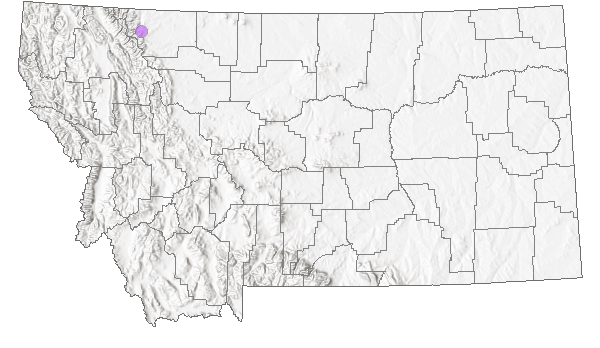
 Native
Native
Range Comments
Collected from Glacier County. AK south to MT, QC; Asia (Lesica et al. 2012. Manual of Montana Vascular Plants. BRIT Press. Fort Worth, TX).
Observations in Montana Natural Heritage Program Database
Number of Observations: 3
(Click on the following maps and charts to see full sized version)
Map Help and Descriptions
Relative Density
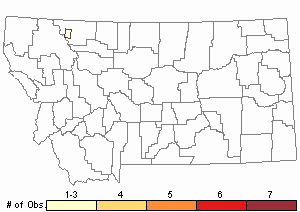
Recency
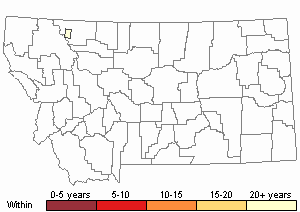
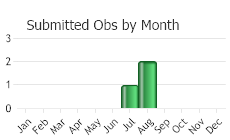
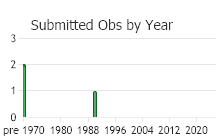
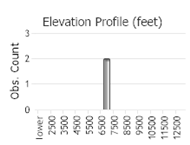 (Observations spanning multiple months or years are excluded from time charts)
(Observations spanning multiple months or years are excluded from time charts)
Habitat
Dry, calcareous barrens, cliffs, and talus slopes in the alpine or subalpine zones.
Stewardship Responsibility
Threats or Limiting Factors
STATE THREAT SCORE REASON
Threat impact not assigned because threats are not known (MTNHP Threat Assessment 2021).
References
- Literature Cited AboveLegend:
 View Online Publication
View Online Publication Lesica, P., M.T. Lavin, and P.F. Stickney. 2012. Manual of Montana Vascular Plants. Fort Worth, TX: BRIT Press. viii + 771 p.
Lesica, P., M.T. Lavin, and P.F. Stickney. 2012. Manual of Montana Vascular Plants. Fort Worth, TX: BRIT Press. viii + 771 p. MTNHP Threat Assessment. 2021. State Threat Score Assignment and Assessment of Reported Threats from 2006 to 2021 for State-listed Vascular Plants. Botany Program, Montana Natural Heritage Program, Helena, Montana.
MTNHP Threat Assessment. 2021. State Threat Score Assignment and Assessment of Reported Threats from 2006 to 2021 for State-listed Vascular Plants. Botany Program, Montana Natural Heritage Program, Helena, Montana.
- Additional ReferencesLegend:
 View Online Publication
View Online Publication
Do you know of a citation we're missing? Lesica, P., M.T. Lavin, and P.F. Stickney. 2022. Manual of Montana Vascular Plants, Second Edition. Fort Worth, TX: BRIT Press. viii + 779 p.
Lesica, P., M.T. Lavin, and P.F. Stickney. 2022. Manual of Montana Vascular Plants, Second Edition. Fort Worth, TX: BRIT Press. viii + 779 p.
- Web Search Engines for Articles on "Rock Sedge"





